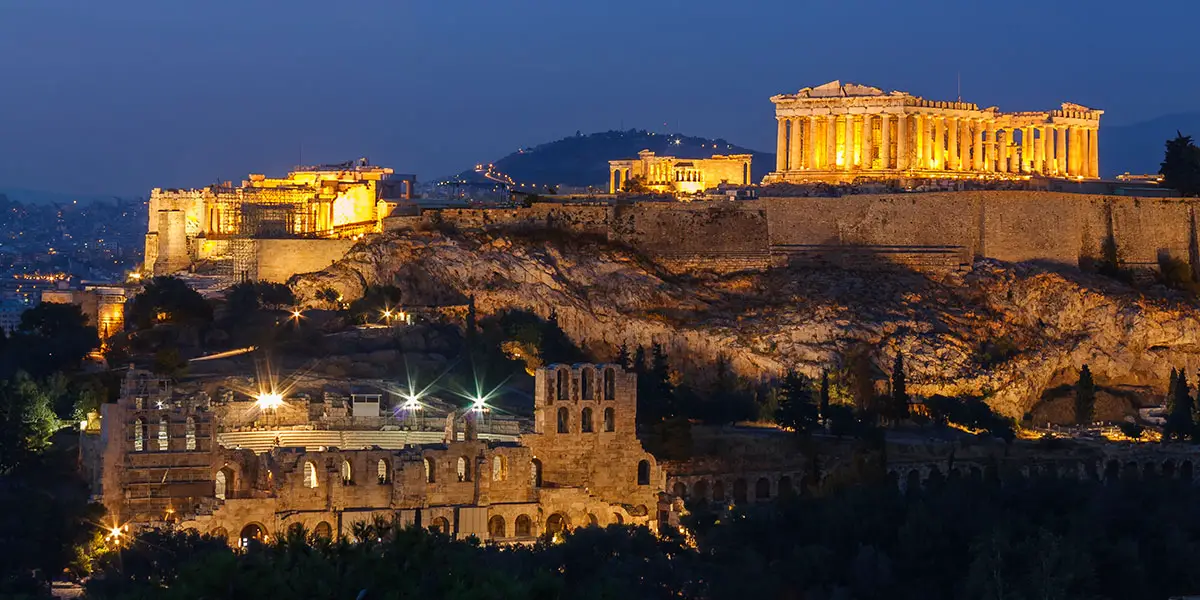Where to See Greek Ruins | A Chronological Travel Guide
At its height during antiquity, the Greek Empire dominated the banks of the Mediterranean, with settlements in over 20 modern-day countries including Turkey, Italy, Cyprus and parts of Northern Africa. In addition to the ruins, this region boasts one of the most pleasant climates on the planet along with ease of travel and mouth-watering cuisine. Each period during the reign of the Greeks contains a fascinating insight into Europe’s first advanced civilization, which influenced much of the western world we know today. We’ll start by exploring these periods, with examples of the best ruins for each, and then provide a summary of the most historically dense regions in which one can explore the ruins of the Greek Empire.
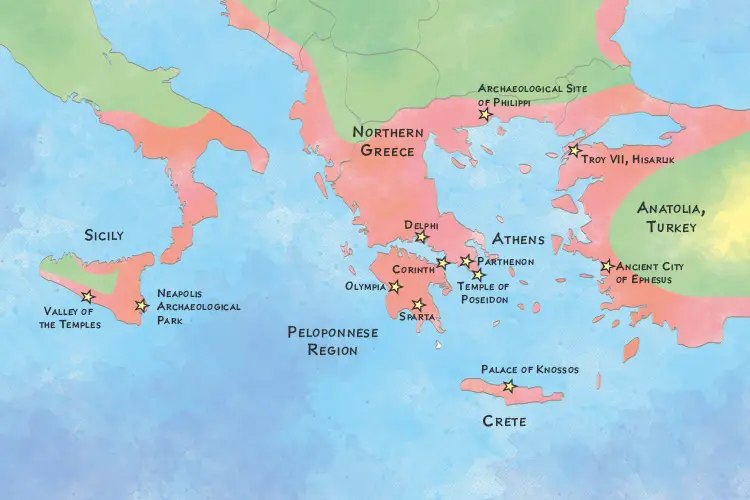
A Brief History of The Greek Empire & Where it was Located
The Aegean Civilization | Early Bronze Age 2000 – 1450 BC
A collective term for the Minoan, Cycladic and Helladic civilizations, the boundaries of what can be considered the start of Greek civilization fall largely within modern-day Greece. The Helladic civilization controlled much of the mainland while the Minoans and the Cycladic civilization controlled Crete and the Cycladic islands respectively. Many of the ruins of this era were destroyed by either the Thean Eruption, a massive volcanic eruption on the island of Santorini, or the period of mass burning and looting during the Late Bronze Age Collapse. Thankfully, there are several sites that remain and many artefacts, including sculptures and pottery, safely housed in museums dotted around Greece.
The 4 Minoan Palaces, Crete
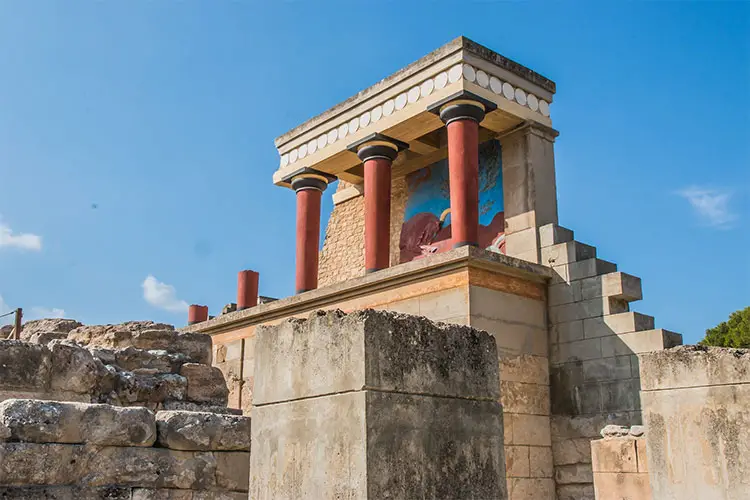
Perhaps the most iconic of the 4 palaces, Knossos was arguably the oldest city in Europe and the archaeological site displays the best-preserved ruins of this era. Its painted red-black pillars and mural offer the best insight into what these ruins would have looked like during their heyday. 3 of the palaces are relatively close together. Knossos and Malia are a 35-minute drive apart and Phaistos, on the south coast, is an hour from Knossos. Zakros is a further 2.5-hour drive from Malia on the far eastern side of the island, although, this region of Crete is stunning and, being the furthest away from the island’s International air and ferry ports, is the least visited.
The Mycenaean Civilization | Late Bronze Age 1600 – 1100 BC
Largely considered to be the first advanced civilization on mainland Greece, the Mycenaeans expanded the territory of the Greeks into Anatolia in modern-day Turkey. This period plays host to several of the most famous Greek myths, including Hercules and the Siege of Troy. In fact, Homer’s two epic poems, the Iliad and the Odyssey are based around the latter of these two myths; the Iliad details the Trojan War and the conflict between Agamemnon and Achilles, while the Odyssey details the journey home of Odysseus, one of the war’s great heroes. I digress. While many of the ruins of this period were also destroyed during the Late Bronze Age Collapse, there are several sites preserved remarkably well, all things considered.
Troy VII, Hisarlik, Turkey
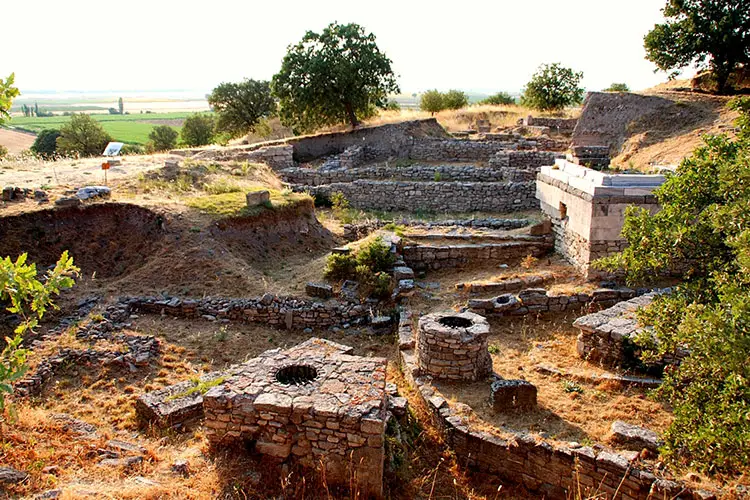
After some debate in the historiographic community, Hisarlik, named Ilion in Homer’s Iliad, is widely accepted as the location of the ancient city of Troy. Whether the Battle of Troy actually took place or not, there still remains an archaeological layer of Hisarlik named Troy VII, which dates back to Mycenaean times from 1300 to 950 BC. Found in the north-west corner of Anatolia, the Archaeological Site of Troy was excavated in 1870 and designated a UNESCO World Heritage Site. Points of interest include an array of foundations, theatre ruins you can walk around and a museum, which is found just under a kilometre from the archaeological site.
Mycenae & the Lion Gate, Peloponnese
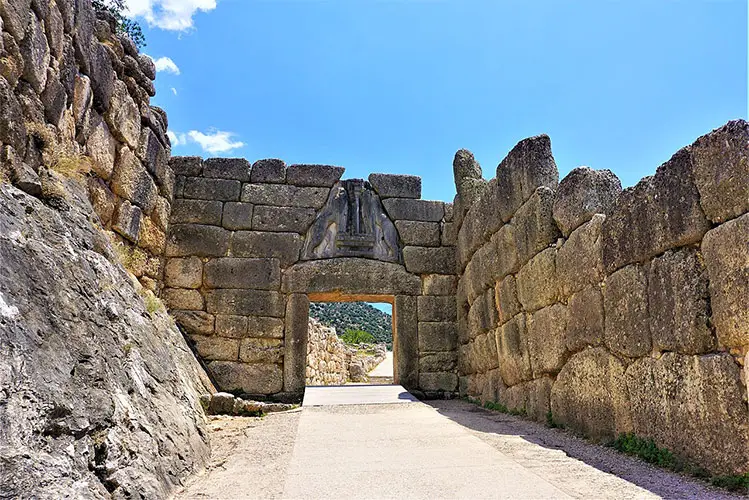
30 miles south of Corinth in the Peloponnese region of Greece, the citadel of Mycenae, along with another Mycenaean citadel, Tiryns, were designated a UNESCO World Heritage Site in 1999. Mycenae was the proud centre of the Mycenaean Civilization and this archaeological site contains the ruins of a megaron, a grand central hall, Cyclopean walls and the Lion Gate. The most recognisable of the ruins at Mycenae, the Lion Gate was the primary entrance to the citadel and features a wonderful example of Cyclopean masonry, two lions carved into a massive limestone boulder.
The Greek Dark Ages – 1,100 – 800 BC
A particularly bizarre and relatively unknown period in history, the Late Bronze Age Collapse not only affected Mycenaean Greece but most of the civilizations surrounding the western Mediterranean. This period of destruction saw almost every major city destroyed and ushered in the region’s Dark Ages. Subsequently, the next few centuries were spent rebuilding what was destroyed and there aren’t any ruins of note from this period.
Ancient Greece | The Archaic Period 800 – 480 BC
To rise from the ashes; to emerge renewed, revitalised, or reborn as something different following some total destruction or ruin. If there is a better example of this idiom than Ancient Greece, I’m not aware of it! Lasting roughly three centuries, this period saw the rise of, and conflict between, the great cities of Athens, Sparta and Corinth and gave birth to the Olympic games in 776 BC. Trade also grew substantially during this time and was responsible for the Great Colonisation of the Mediterranean. During this period, the Greek Empire began to take shape, expanding to over 20 modern-day countries, with settlements spanning the Mediterranean from modern-day Spain to the banks of Georgia and Russia. For the intrepid traveller, this opens up a wide range of countries one can visit in search of greek ruins.
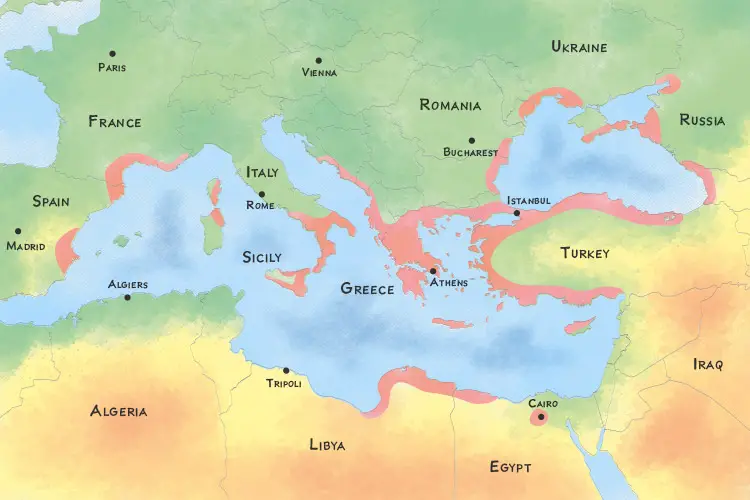
This rise from the ashes tale was not only true for Greek civilization but even more so for the Persians. Around 550 BC, Babylon was quickly becoming the centre of the world, the Persians had conquered most of Asia and Greek colonies around Anatolia began to fall to this great empire. This ignited a 50-year series of epic battles known as the Greco-Persian War, which included such historical events as the Battle of Marathon in 490 BC and the legend of just 800 Spartans holding back the Persian invasion. The Greco-Persian Wars ended with Greece taking back Anatolia and reaching the height of its empire up to this point. One of the cultural areas showing the most growth during this period was architecture, with now famously Greek columns becoming prevalent in many of the large structures built during this period and leaving behind some of the most famous of all the Greek ruins.
Archaeological Site of Delphi
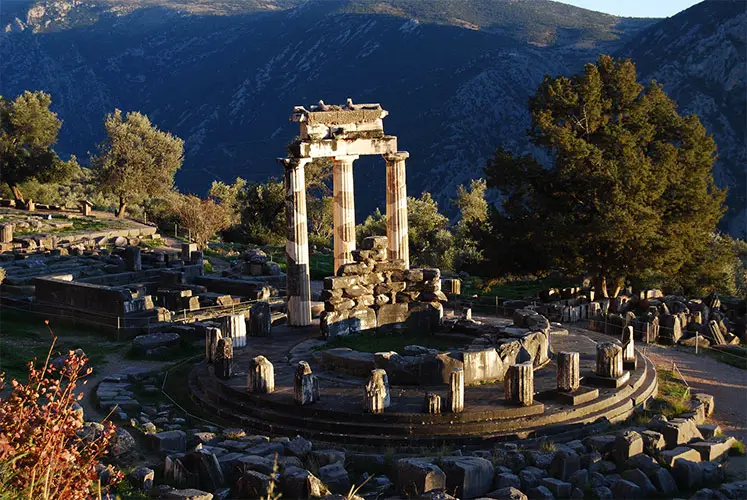
Another UNESCO World Heritage Site, the Archaeological Site of Delphi is just over a 2-hour drive northwest of Athens in the foothills of the Pindus mountain range. If you’ve explored the busy streets of the capital for a few days, the tranquil drive up to the site of Delphi is worth it on its own merit. The site includes a spectacular mountain-enclosed theatre and several reconstructed elements including an Athenian Treasury and a Tholos or temple. The Tholos, pictured above, is a great example of Doric architecture, in particular their columns, which you’ll recognise from many of the other ruins in Greece.
Ancient City of Corinth
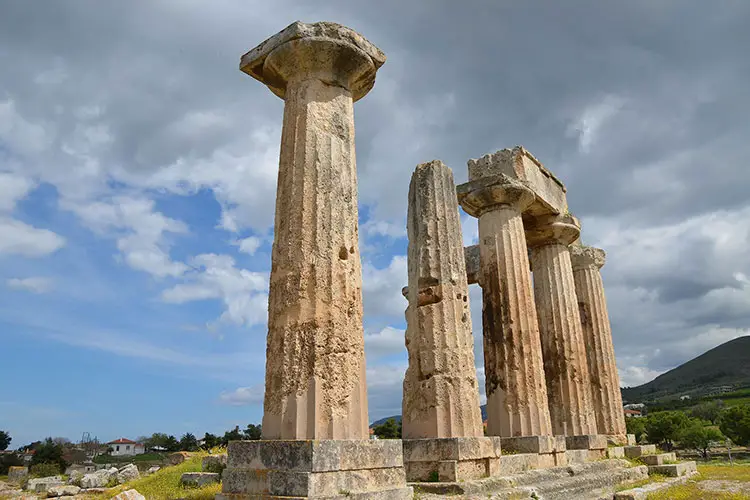
Corinth is strategically placed on the isthmus between the Attica and Peloponnese regions of Greece, which allowed them to control trade between these centres. Unlike Athens, the Archaeological Site Of Corinth is separated from the modern city, lying several kilometres to the south-west. The site’s most famous ruin is the Temple of Apollo, each column is made from a single piece of stone and remains remarkably well intact. Being such a strategically positioned city, Corinth was highly valued by the Romans as well and many of the ruins of this period can also be seen at this site.
Archaeological Site of Sparta
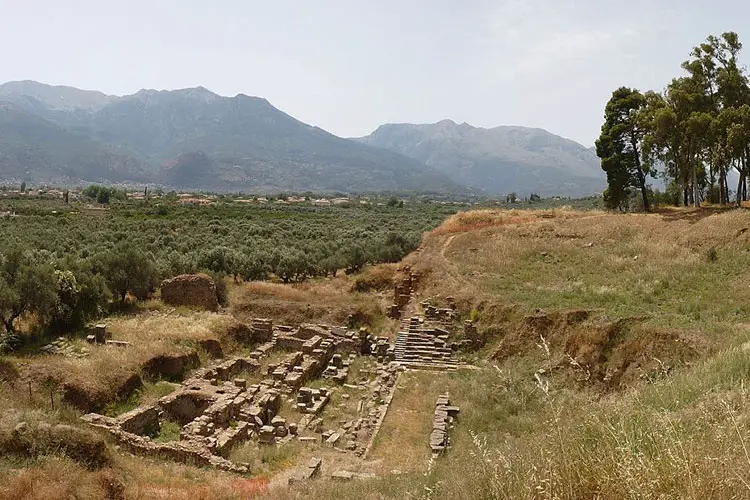
Of the three sites mentioned for this period, the ruins of Sparta are easily the least impressive but nonetheless important given the myth-like reputation of the Spartans. This site itself contains a small theatre and some interesting stone blocks bearing ancient Greek inscriptions. The modern town of Sparta is quaint in comparison to its larger counterparts and is decorated with bronze statues immortalising Spartan legends like Leonidas. If you decide to include Sparta in your itinerary be sure to check out the town’s centrally-located Archaeological Museum, which houses many of the artefacts found at the site and displays pieces that predate Greek times all the way up to the Roman occupation.
Classical Greece | The Classical Period 480 – 323 BC
Of all the eras in Greek history, the Classical Period is the most well-known and is to credit for the most impressive & well-kept ruins. This period begins with the successful recapture of Anatolia and is commonly thought of as Greece’s renaissance. Science and Philosophy were valued highly during this period with Plato founding the Academy, where Aristotle studied for several years, in 387 BC. Art and Literature were also highly valued during this time, leaving behind a collection of beautiful theatres and sculptures. At this point in Greece’s tumultuous history, there were two major states left, Athens and Sparta, who battled intermittently during this period. The warring ceased briefly with the signing of the Thirty Years’ Peace treaty in 446 BC but was resumed not long after with the beginning of the Peloponnesian War in 431 BC. This era, and arguably with it the height of the Greek Empire, came to a close in the early 4th century BC with the death of Alexander the Great who had come from the north to conquer all of Greece and subsequently most of Asia.
Parthenon, Athens

The great Parthenon which sits atop Athens’ Acropolis, was Built between 447 – 438 BC by Pericles, a general who is credited with much of Athens’ stellar reputation during its golden age. It is generally thought of as the best example of the Doric order, an architectural style known for its simplistic appearance when compared to the other classic orders. Originally built as a temple, this impressive structure eventually became Athens’ treasury and was later used as a church by the Romans and a mosque by the Turks. In addition to the Parthenon, Athens’ Acropolis also features many other fascinating sites you can visit including the Erechtheion, the Propylaea and the Odeon of Herodes Atticus, all pictured above.
Temple of Poseidon at Cape Sounion
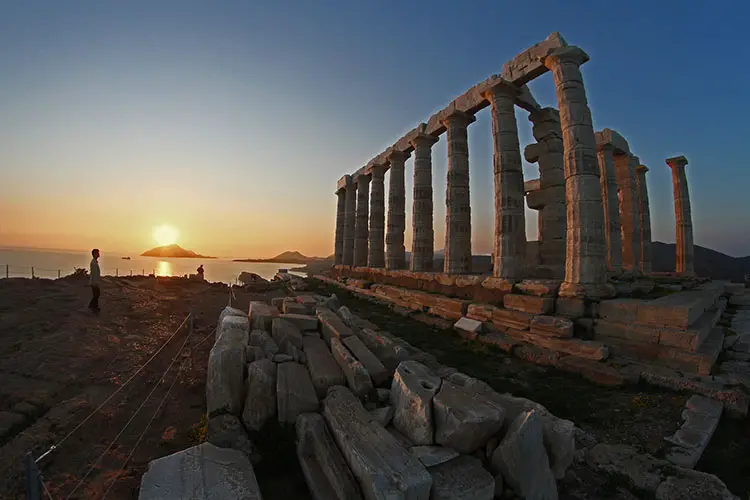
It’s hard to think of a better tribute to Poseidon, Greece’s mythological god of the sea, than the temple at Cape Sounion. Just over an hour south of Athens, this temple sits at the southern tip of the Attic peninsula overlooking the Saronic Gulf and is worth a visit for the view alone. Another example of Doric architecture, the temple has been rebuilt several times and of the original 38 white marble columns, 16 remain. Sunset is one of the best times to photograph the temple and the site also features a cafe where you can sit and watch the sun disappear into the gulf.
Epidaurus Theatre, Peloponnese
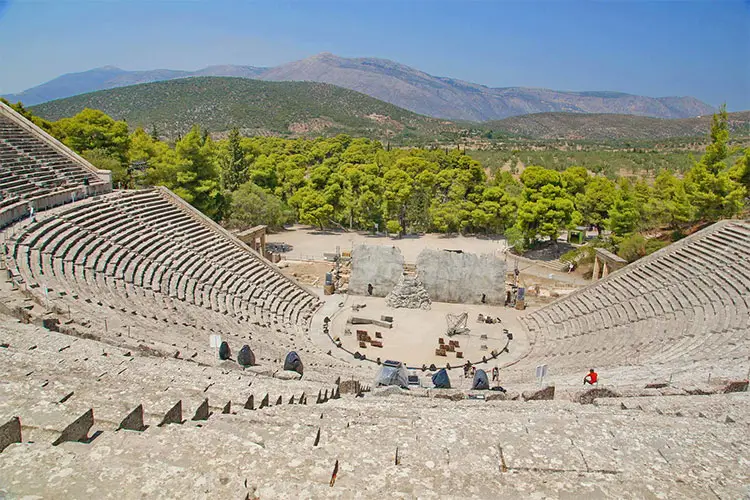
If you visit only one theatre on your trip to Greece, simply put, Epidaurus should be it. Known as the best-surviving theatre from Ancient Greece, this gigantic structure can house up to 14,000 people and boasts spectacular views of the surrounding landscape. Designated a UNESCO World Heritage Site, the theatre is famous for its acoustics and still hosts plays and concerts there to this day. Be sure to check out the archaeological museum, which houses many immaculate sculptures and other artefacts. Epidaurus is only 45 minutes southeast of Mycenae and well worth the visit if you’re in the Peloponnese region.
The Macedonian Empire | The Hellenistic Period 323 – 146 BC
Meaning “to imitate Greeks”, the Hellenistic Period begins with the passing of Alexander the Great after his conquest of the Persian Empire and ends with Rome’s conquest over the Corinthians at the battle of Corinth. Unfortunately, Alexander’s empire collapsed quickly following his death and was split up between his generals sparking the Diadochi Wars. During his epic conquest, Alexander left behind very little resembling ruins, and this period has often been neglected by historians. One of the most famous sculptures in the world still remains, however, and is proudly on display at one of the world’s most celebrated museums.
Nike of Samothrace, The Louvre, France
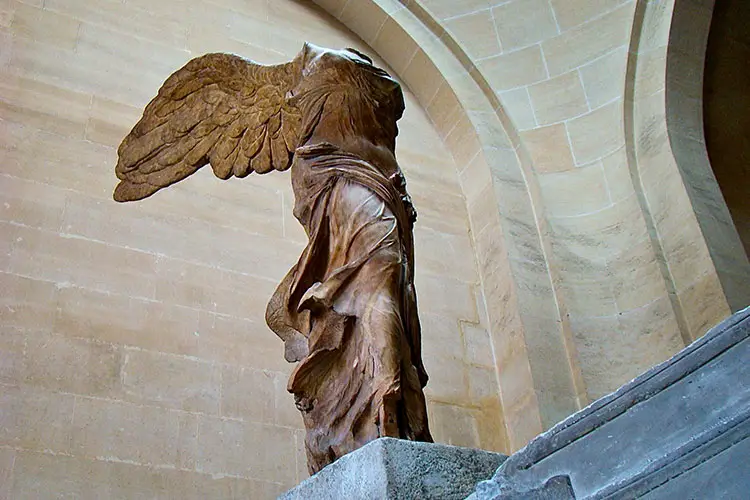
Not strictly a ruin per se, but well worth a mention. Depicting Nike, the goddess of victory, this sculpture was found on the Greek island of Samothrace in the north Aegean sea in 1863 and is thought to have commemorated a battle at sea. Most likely not worth the trip if you’re in Greece strictly for the ruins, if you ever happen to be in Paris, take a trip to the Louvre so see this symbolic monument to Europe’s first great empire.
The Best Places to See Ruins of The Greek Empire
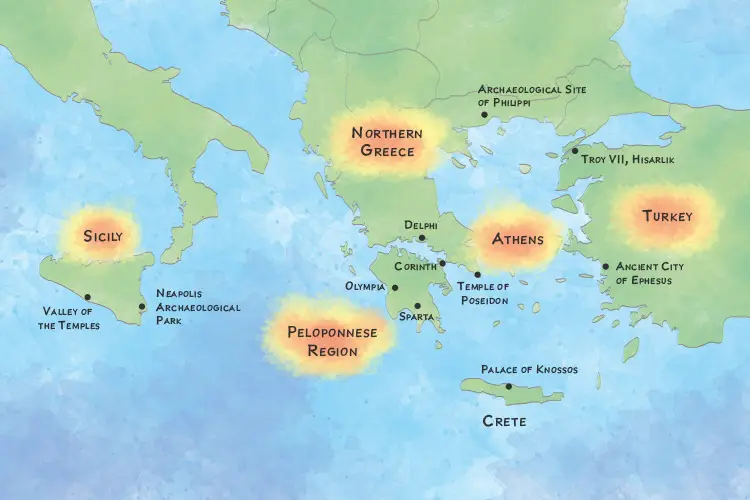
The Peloponnese Region
Although Athens is certainly thought of as the best place to see Greek ruins, I happen to disagree! Home to the great cities of Sparta and Corinth, the Peloponnese plays host to more UNESCO World Heritage Sites than anywhere else in Greece and most of them pertain to the Greek Empire, including the two examples below. I can think of much worse things to do than spending a week or two driving around this peninsula, and its proximity to Athens itself means you can easily tick off both of these places in the same trip.
Olympia
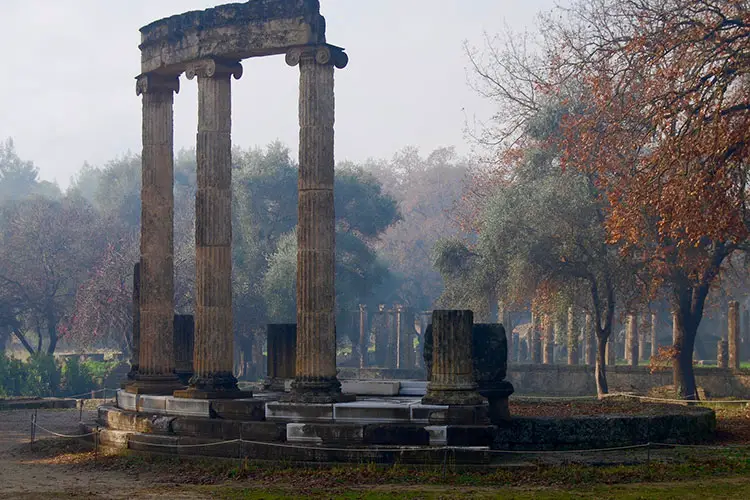
In the northwest corner of the Peloponnese peninsula, you’ll find the ancient site of Olympia, which hosted the Olympic games for 4 centuries between the 8th and 4th centuries BC. Although not standing in their entirety, the remains at this site are in better shape than many others on this list and, with a bit of imagination, give you a true sense of what it must have been like to compete at the games in ancient times. In addition to the ruins, Olympia has two museums, the Archaeological Museum of Olympia presents artefacts found at this and other sites across Greece. The other, the Museum of the History of the Olympic Games of antiquity, is dedicated to telling the story of the Olympic games and how it evolved over centuries.
Temple of Apollo Epicurius
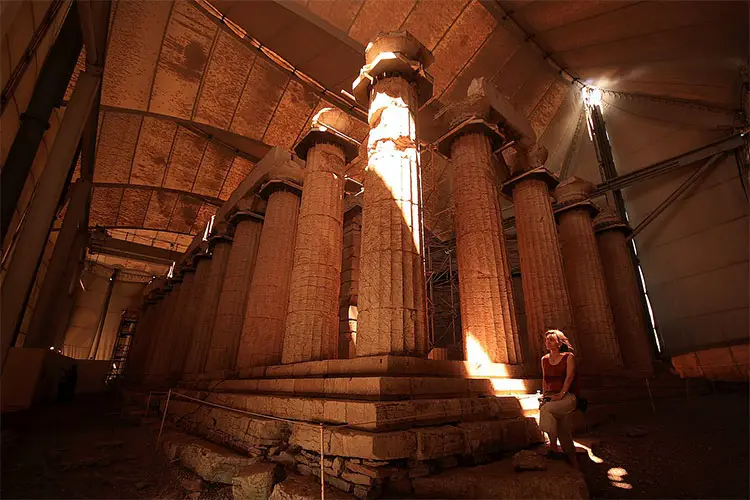
The Archaeological site at Bassae is just over an hour and a half drive south of Olympia on the western side of the Peloponnese and is most famous for its temple dedicated to Apollo Epikourios, one of the most important Greek gods. Like many of Greece’s great ruins, the site at Bassae sits in a remote mountainous landscape, it should come as no surprise then that Apollo was a god of healing among other things. At the time of writing in 2020, the temple is covered in a white tent to protect the ruins as renovations are carried out, however, even inside the tent you can easily appreciate its grandeur and a trip to this tranquil part of Greece is an absolute must.
Athens
One of the most enchanting capital cities in the world, the bustling streets of Athens sit beneath the Acropolis and Mount Lycabettus. Thanks to its Golden age during the fifth century, Athens has some of the most spectacular ruins you’ll find and is the closest location on this list to Greece’s main International Airport. In addition to the Greek ruins, Athens also has many Roman-era concert halls and churches. As with most capital cities, Athens is incredibly easy and cheap to navigate, allowing you to visit many sites on the same day. The accommodation options in Athens are also unparalleled along with its range of restaurants, cafes, bars and other amenities.
Theatre of Dionysus
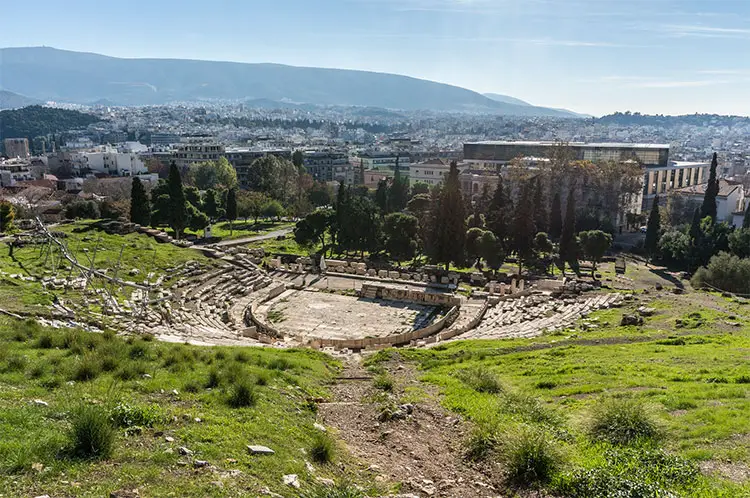
Another famous site at the Acropolis, on its southern bank, this is the oldest theatre in Athens and dedicated to Dionysus, the son of Zeus and Semele, who was a god of wine and ecstasy (nope, the actual meaning of ecstasy). In its heyday, the seating area would have hosted around 15 thousand people and surrounded a dome-shaped orchestral area in front of the main stage. The theatre is just a stone’s throw away from a handful of other amazing attractions including the Acropolis Museum, which is just across the road, the Acropolis itself and the Temple of Olympian Zeus.
Temple of Hephaestus
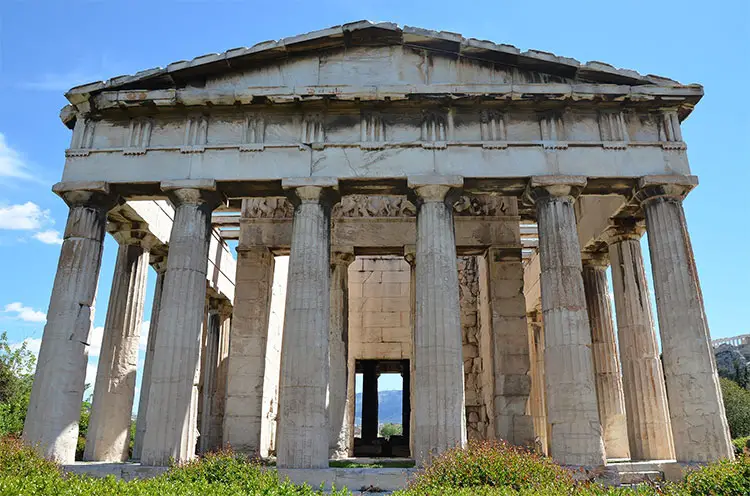
To the northwest of the Acropolis, you’ll find one of the best-preserved ruins in Athens, in the middle of Thissio park. Another structure commissioned by Pericles, the temple took over three centuries to finish and is another classic example of Doric architecture. A huge structure with all of its 34 columns intact, the temple is over 30 meters long and is an incredible feat of engineering given the technology available at the time. The site is just across the road from Thissio subway station and sits next to the Church of the Holy Apostles, a Greek orthodox church (not from the same period) that is well worth checking out if you’re in the area.
Athens’ Museums
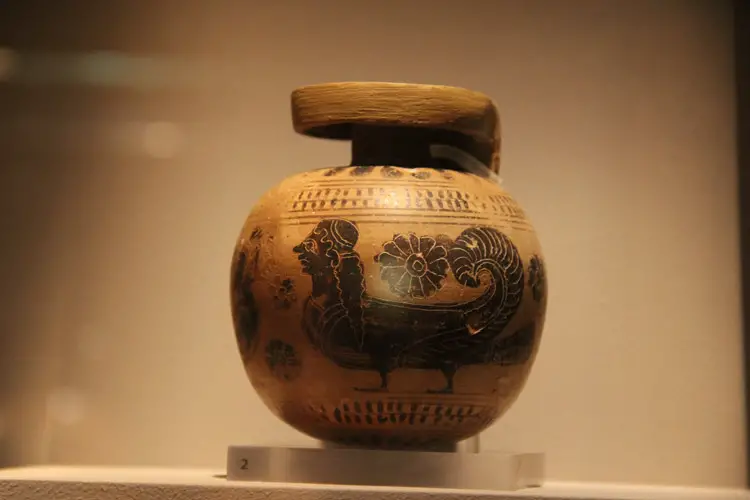
If you’re in Athens for the ruins it would be a shame to miss its impressive array of museums. In addition to the famous Acropolis Museum and the National Archaeological Museum, stop by the Museum of Cycladic Art if you’d like to learn a little more about this early period. This 25-year old museum, occupying 4 floors contains a collection of ancient Greek art with a focus on artefacts from the Cycladic islands. This is one of the best places to see well-preserved Cycladic sculptures along with pottery from the Classical and Hellenistic periods. The museum is easily accessible via the Athens transit system and is just over the road from the archaeological site of the Lyceum of Aristotle.
Anatolian Coast, Turkey
The first of our lesser-known locations for Greek ruins, Turkey’s Anatolian coast was part of the Greek Empire on and off for centuries. First settled by the Myceneans in 2nd millennium BC, this strip of coastline was hotly contested with the Persians for many years. Turkey also contains many Roman ruins and a lot of the sites contain examples of architecture from both empires. If you would like to extend your trip from Greece or just explore somewhere a little more off the beaten track, Turkey offers a wonderful collection of ruins with the added ability to visit other Turkish highlights such as Pamukkale and Istanbul.
Temple of Apollo, Didyma
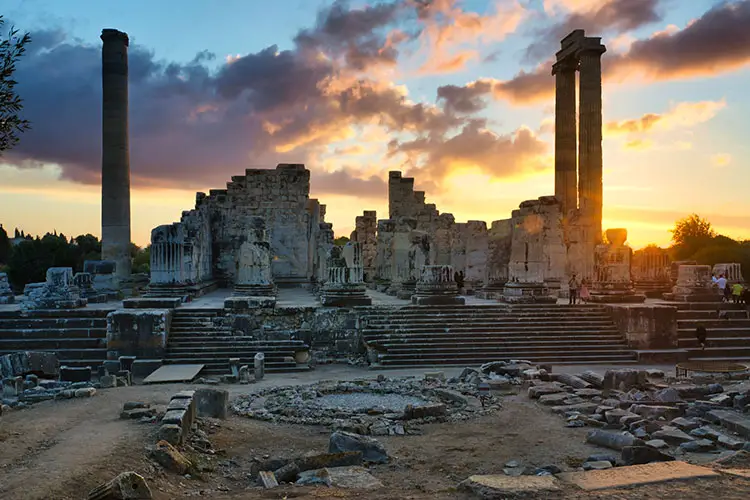
Didyma sits on the southwest coast of the Anatolian peninsula, in the Turkish riviera. Unfortunately, much of this sanctuary was destroyed over the years, however, unlike many of the simplistic columns you’ll see from this era, many of the column bases and capitals at Didyma are intricately designed with carvings of mythological beasts and patterns. The most famous ruin at the site is a temple dedicated to Apollo, pictured above, which was initially built in 700 BC but destroyed and rebuilt over the years as the Greeks and Persians warred over this land. The sea in this region is an almost indescribable shade of blue and it would be a travesty not to explore this stretch of coastline while you’re in the area.
Ancient City of Ephesus
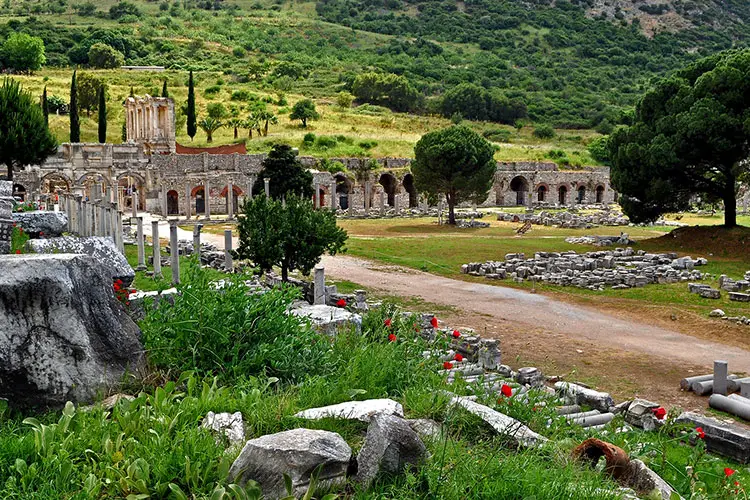
Although the best-preserved ruins at Ephesus are from Roman times, this ancient city was an important Greek centre belonging to the Ionian League, an alliance of 12 city-states during the Classical era. This city has a rich history with archaeological evidence dating from the Mycenaean period, through Ancient and Classical Greece and into the Roman occupation of the region. Interestingly, the city used to lie on the banks of the Mediterranean, which is now 3-4 kilometres further west. A long street decorated with columns runs from the old harbour to a theatre and offers an immersive insight into what it might have been like to live in this ancient city. Ephesus is around an hour and a half north of Didyma.
Sicily
Another place not often thought of as the classic location for Greek ruins, Sicily was settled by the Greeks during the Great Colonisation of the Mediterranean in the Archaic period. In addition to housing some of the best-kept ruins from Ancient Greece, Sicily is also one of the nicest areas in the Mediterranean, with many additional sites to visit including several volcanoes. Unfortunately, at the time of writing, there are no ferries from Greece to Sicily, so if you’re exploring Greece first, fly from Athens International Airport where you’ll find the widest range of flights.
Valley of the Temples
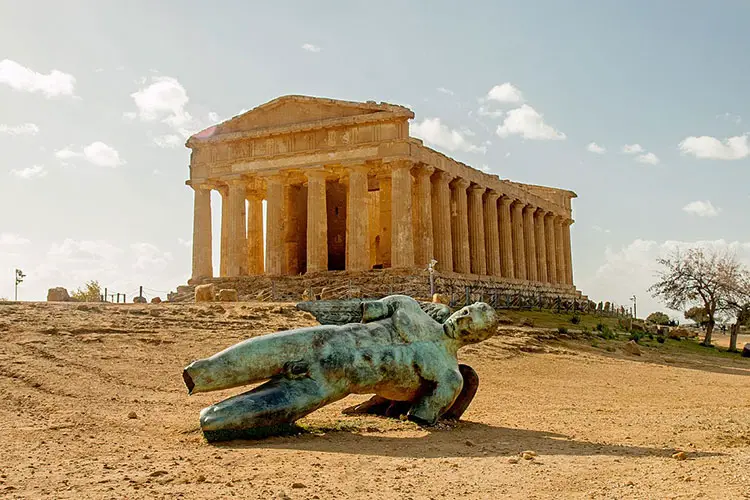
As you no doubt guessed from its title, this archaeological site in the centre of Sicily’s south coast is home to a collection of temples dedicated to various Greek gods. Most of the temples here are Doric in style and constructed in the 5th century BC, the Temple of Concordia is particularly impressive. Also known as the archaeological area of Agrigento, this site was designated a UNESCO world heritage site in 1997 for being “an extraordinary testament of Greek civilization in its exceptionally preserved condition”. Aside from being historically fascinating, the Sicilian coastline lies a mere 2-3km from the site, which is lined with quaint harbours and long sandy beaches.
Neapolis Archaeological Park
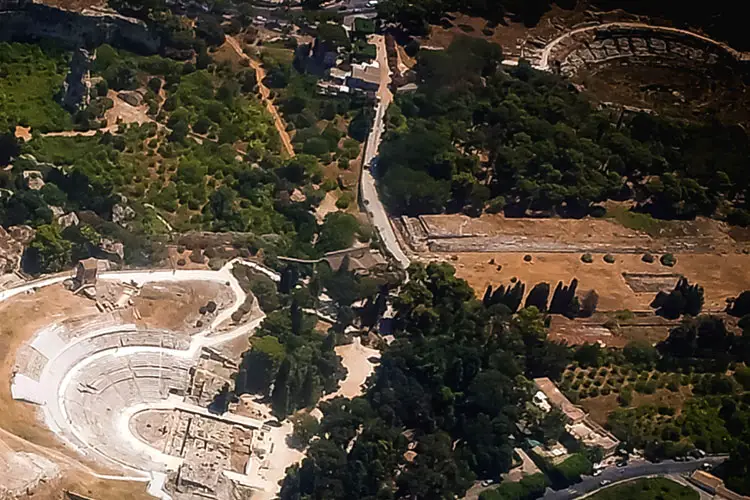
A UNESCO site containing both Greek and Roman ruins, the Neapolis Archaeological Park sits on Sicily’s east coast in the city of Syracuse. Of all the ruins at the site, the most impressive, in my opinion, is the Greek theatre. Be sure to check the theatre’s performance schedule as this is something you won’t want to miss. The performances, especially those in the evening, are incredible to watch and the amount of effort put into the production, stage, props and costumes is clear. During the day, hike to the top of this theatre for a spectacular view of the Mediterranean’s Ionian Sea.
Northern Greece (Ancient Macedonia)
Last but most certainly not least, northern Greece may not contain the number of impressive ruins its southern equivalents do, however, the historical importance of this region is undeniable. Northern Greece, or Macedonia as it was known at the time, was home to two of the Hellenistic Period’s heroes, king Philip II and his son, Alexander the Great. There are two UNESCO World Heritage Sites in northern Greece, including the capital of Macedonia, Aigai. For any history buff or anyone looking to extend their stay in Greece, a trip up to the less-visited northern half of the country will not disappoint.
Archaeological Site of Philippi
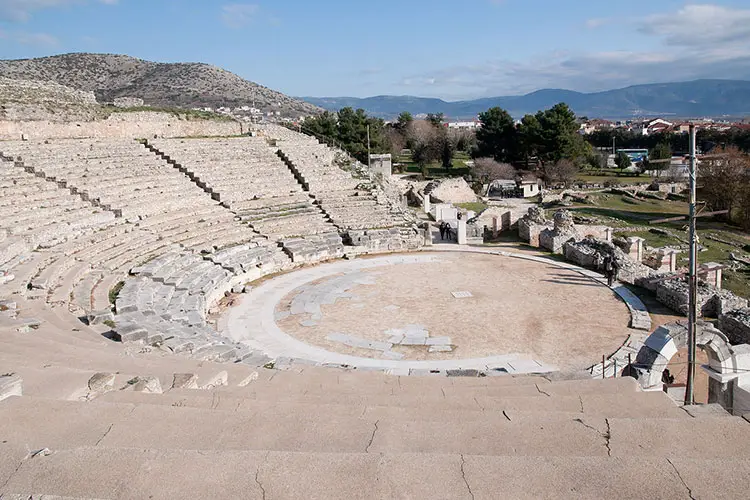
Founded in the 4th century BC under a different name, the site was an important fortified city of the aforementioned king Philip II after he conquered it in 356 BC and renamed it, Philippi. The site contains an impressive theatre, an intricate structure of foundations and walls and the city’s main gate. The Archeological Museum of Philippi is well worth a visit with its collection of both Greek and Roman artefacts including sculptures and statues, pottery and a model of what the town would have looked like in ancient times. The other UNESCO site in Northern Greece, Aigai, lies just over two hours east of Philippi and would be a shame to miss if you’re in the area.
